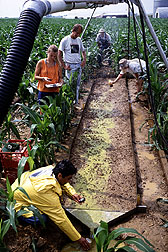This page has been archived and is being provided for reference purposes only. The page is no longer being updated, and therefore, links on the page may be invalid.
|
|
White Powder Anchors Farmland SoilBy Hank BeckerSeptember 22, 1997 Irrigation water coursing down farmland furrows takes little if any topsoil with it if farmers carefully add a white powder known as a polyacrylamide--or PAM--to the water. The idea is not new, but extensive outdoor tests by scientists with USDA's Agricultural Research Service were instrumental in garnering regulatory approval for PAM. Within the past 3 years, 13 western states have okayed on-farm use of water-soluble, negatively charged polyacrylamides. Tests by ARS scientists Robert E. Sojka and Rodrick D. Lentz at Kimberly, Idaho, have shown that just one ounce of PAM anchors up to 1,000 pounds of topsoil. Sojka and Lentz say water-soluble agricultural polyacrylamides are a safe, convenient weapon for fighting erosion. The prescribed rate to apply PAM is 10 parts per million. That is a tablespoon of the compound for every 750 gallons of irrigation water until the first of this water reaches the end of the furrow. The scientists' new assay for measuring PAM residues in runoff water shows that more than 99 percent of the compound, when properly applied, remains on the treated field and biodegrades. The September issue of ARS Agricultural Research magazine tells more about the investigations. See it on the World Wide Web at: /is/AR/archive/sep97/pam0997.htm A related story in the magazine tells how scientists at ARS’ National Soil Erosion Research Laboratory in West Lafayette, Ind., conducted field tests to examine how both PAM and gypsum affect erosion on a steep, erodible silt loam soil. Gypsum is a byproduct of removing sulfur from flue gases in coal-fired power plants. West Lafayette-based researchers also are working with colleagues at ARS’ National Center for Utilization of Agricultural Resources, Peoria, Ill., on developing a starch-based copolymer as an alternative to PAM, which is a natural gas-based polymer. The magazine story on the West Lafayette studies is on the WWW at: /is/AR/archive/sep97/gypsum0997.htm Scientific contacts: Rodrick D. Lentz, ARS Northwest Irrigation and Soils Research Laboratory, Kimberly, Idaho, phone (208) 423-5582, fax (208) 423-6555, lentz@kimberly.ars.pn.usbr.gov; L. Darrell Norton, ARS National Soil Erosion Research Laboratory, West Lafayette, Ind., phone (765) 494-8682, fax (765) 494-5948, nortond@ecn.purdue.edu. |

